Thailand Raptor Birding Tour
 26th October – 5th November 2025: Thailand raptor birding tour highlights include Black Baza, White-bellied Sea Eagle, Pied Harrier, Grey-faced Buzzard, Lesser Fish Eagle, Crested Serpent Eagle, Chinese Sparrowhawk, Greater Spotted Eagle, Black-thighed Falconet, Malaysian Plover, Spoon-billed Sandpiper, Oriental Honey-buzzard, Spot-billed Pelican, Eastern Marsh Harrier – £3200 per person
26th October – 5th November 2025: Thailand raptor birding tour highlights include Black Baza, White-bellied Sea Eagle, Pied Harrier, Grey-faced Buzzard, Lesser Fish Eagle, Crested Serpent Eagle, Chinese Sparrowhawk, Greater Spotted Eagle, Black-thighed Falconet, Malaysian Plover, Spoon-billed Sandpiper, Oriental Honey-buzzard, Spot-billed Pelican, Eastern Marsh Harrier – £3200 per person

Trip Details
- Dates: 24th Oct – 4th Nov 2025
- Cost: £3200
- Single Supplement: £500
- Deposit: £500
- Tour length: 11 Days (9 days birding)
- Min / Max group size: 5 / 12
- Start/Finish: Bangkok
- Tour Type: Birding
- Photo Opps: Good
- Physicality: Moderate
- Tour Leaders: Nick Upton & Wich’yanan Limparungpatthanakij
Contact us if you have questions about this trip – info@calidrisbirdingtours.com
Thailand Birding for Raptors
There can be few spectacles in birding more impressive than the mass migration of raptors. In late October the largest numbers of raptors migrating in East Asia pass through the bottleneck of the peninsula of Southern Thailand, navigating the coastal plains between the Tenassarim mountain range and the Gulf of Thailand. Through the October migration period more than two hundred thousand raptors pass through this region with some highly sought-after Asian species. On top of witnessing several days of this migration we shall be visiting Sundaic tropical forest, incredible limestone karst scenery at Chieow Larn Lake, rice paddies, areas of coastal vegetation, misty lowland forest and salt farms full of a great variety of shorebirds.
Thailand experiences one of the largest mass migrations of raptors in the world but was poorly documented until the early 2000s and since then the number of species know to be passing through has continually grown. The forests of this region have a number of impressive resident raptors too, which we will also be searching for but the inclusion of a variety of habitats means that this trip is more than only raptors, indeed, the timing has been planned to coincide with the arrival of one of the most sought-after shorebirds in the world; Spoon-billed Sandpiper. With forest species, migrating raptors and passerines, rice-field species as well as shorebirds the diversity and number of birds we are likely to see on this birding tour is impressive.
While this is a raptor-oriented tour, with flocks of superb Black Bazas, identification challenges with Accipiters, majestic White-bellied Sea Eagle, handsome Grey-faced Buzzards and the awesome Pied Harrier, there will be much more for birders to enjoy. Searching for some of the world’s rarest shorebirds in the form of Spoon-billed Sandpiper, Nordmann’s Greenshank and Asian Dowitcher will be exciting, while if you like seeing lots of species quickly then a visit to the rice fields will be a fun experience. Forest birding is trickier but with a variety of colourful species such as Black-and-yellow Broadbill and massive Great Hornbill visiting this habitat will add some memorable birds. Although our aim is finding as many raptor species as possible in a relatively small part of the country, this trip will also provide a great variety of excellent birds.
Day 1, Arrival in Bangkok – 26th October 2025
Flights will arrive at Suvarnabhumi International Airport from mid-morning to mid-afternoon. You will meet the hotel shuttle bus at the airport and travel the short distance to our comfortable hotel. In the early evening you will meet your guide and then there will be a pre-trip briefing and dinner. Here you will get a good night’s sleep before an early start the next morning.
Day 2, Petchaburi Rice Fields – Chumpon – 27th October 2025
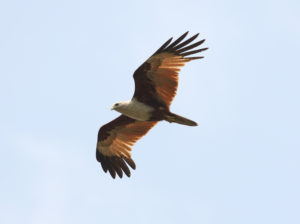
We plan to leave Bangkok at 5am to beat the city’s notorious traffic. We should arrive in the rice fields close to Petchaburi a little before 7am, just as it is getting light, an excellent time to be at this location. Pink-necked Green Pigeons sitting on roadside wires and bushes should provide some early colour for us and it is a good time to tease Chestnut-capped Babbler out from thick vegetation. Wetland species should include Bronze-winged Jacana, Intermediate Egret, Purple Heron, Yellow Bittern and Asian Openbill with good numbers of Oriental Darter flying overhead. Asian Golden Weavers should be forming flocks along with Baya and Streaked Weavers with some males still in partial breeding plumage at this time of year. If the water levels are right we might be able to find Cotton Pygmy Goose, White-browed Crake and Pheasant-tailed Jacana while Lesser Whistling Duck should be more obvious. Visiting these rice fields is a good way for us to see a lot of birds quickly on our first morning and with a bit of effort we should be able to add Yellow Bittern, Plain-backed Sparrow and maybe Freckle-breasted Woodpecker to the list. We have selected this location as our first in order to give ourselves a really good start to this birding trip.
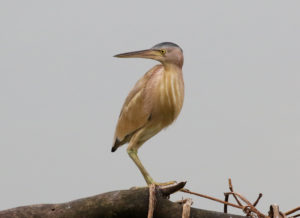
The trip’s first raptors should come in the form of Brahminy Kite and perhaps we will be able to locate migrating Eastern Marsh Harrier or Pied Harrier on our first morning. This is an extensive area of habitat so by driving around the many tracks we should be able to find a wide variety of species including some returning migrants such as Oriental Reed Warbler, Brown Shrike, Stejneger’s Stonechat, Black-browed Reed Warbler and perhaps even Pallas’s Grasshopper Warbler. By mid-morning some passage raptors should be in flight with Oriental Honey-buzzard, Black-eared Kite and Black Baza the most likely candidates but we should be vigilant because almost anything could show up at this time of year.
Nearby fish ponds will give us a change of habitat and with it a change of birds. Here we are likely to find some lingering Spot-billed Pelicans along with Painted Storks, Black-headed Ibis and Indian Cormorants. There is even the chance of a Milky Stork mixed in with the group here! Black-eared and Brahminy Kites usually visit these fish ponds and we might also pick up Western Osprey or even Greater Spotted Eagle looking for an easy meal.
After lunch we will continue our journey south. It takes about three hours to reach Chumpon and check into our comfortable hotel where we will stay the next few nights. In the evening our local guide will give us a photo talk concerning the migrating raptor species that we are likely to see over the next few days. This will be particularly informative when it comes to identifying accipiters.
Day 3, Khao Dinsor Raptor Watchpoint – Panang Tak Bay – 28th October 2025
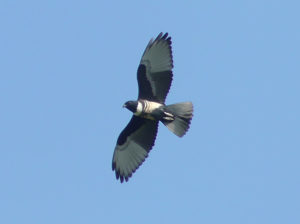
After breakfast at our hotel we will make the short drive to Khao Dinsor. Here we will hike up the hill to a good vantage point for viewing migrating raptors. The hike is not especially long but sections are quite steep and the trail is uneven and rocky so a good level of mobility is required. Once in place we will wait for the weather conditions to be right to bring in groups of migrating raptors, our elevated position giving us a good spotting point to see them early on. Flocks of Oriental Honey-buzzards should be apparent from an early stage and although their plumages can be confusing, their distinctive shape makes them easy to identify. Less confusing are Black Bazas. These superb, medium-sized raptors will come through in flocks of anything from ten birds up to a thousand at a time. This is a really memorable sight.
Another species we can expect to see in large numbers is Grey-faced Buzzard. If you are expecting a confusing Buteo then think again, this species is in the genus Butastur and a smart bird in both adult and juvenile plumages. This East Asian species usually appears in good numbers indeed flocks can be quite large. The passage of this species gives us a good chance to study this handsome East Asia bird. Mixed in among these we will expect some Black-eared Kites as well as some resident raptors including Shikra, Crested Goshawk and Crested Serpent Eagle.
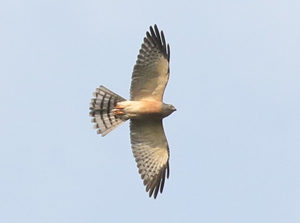
The spectacle of migration is what we are really here for though and flocks of tricky accipiters will definitely test us. We will have large numbers of both Chinese and Japanese Sparrowhawks in an array of plumages to deal with and while the adult males are easy enough to pick out, the females and sub-adults are really tricky. This is where having local experts with us comes into its own who can teach us how to identify these confusing birds. This is also where taking photographs is very helpful too! Among these flocks we hope for some scarcer species too, perhaps Booted Eagle or a Pied Harrier.
From our elevated spotting area we should also pick out a few migrants that are not raptors also. Common species such as Ashy Drongo and Blue-tailed Bee-eater are almost certain but there could be Ashy Minivets, Dollarbird or even White-throated Needletail, small numbers of which are seen here every year. Although it might be mundane to many visiting birders, Common Swift is a prized rarity here at this time of year. It serves to outline that during migration anything can turn up making it an interesting time to be birding here.
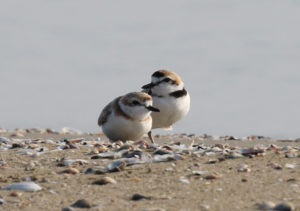
By mid-afternoon the numbers of birds has grown smaller so we can spend the last few hours of the day birding at nearby Panang Tak Bay. This area of coastal vegetation on a secluded beach is home to small numbers of Malaysian Plovers, a declining bird restricted to sandy beaches in Southeast Asia. We should be able to see these and a few species of returning shorebirds such as Lesser and Greater Sand Plovers, Whimbrel, Red-necked Stint and perhaps a few surprises.
Other birds we can look for at Panang Tak Bay include Collared Kingfisher in mangrove remnants, Stork-billed Kingfisher hiding in coastal plantations, Blue-tailed Bee-eater, Greater Racket-tailed Drongo as well as passage migrants that could include Yellow-rumped Flycatcher, Blue-throated Bee-eater and Forest Wagtail. This is a good place for birding during migration and it is hard to predict what we might see.
Day 4, Khao Dinsor Raptor Watchpoint – 29th October 2025
We will have another morning and early afternoon at Khao Dinsor raptor watch point to experience some close views of large numbers of common passage migrating raptors. Among the groups of Oriental Honey-buzzards, Black Bazas, Grey-faced Buzzards and accipiters, there are always small numbers of much scarcer species that get spotted at this location. Small numbers of Short-toed Eagles pass through here annually while we might expect single figures of species such as Pied Harrier, Greater Spotted Eagle and Booted Eagle on both days.
Picking out Eurasian Sparrowhawk might be tricky but small numbers of Crested Goshawk should be easier. We expect a few migrant and resident Peregrine Falcons and we might be lucky with Amur Falcon which passes through northern Thailand at this time of year; a few birds usually get seen in the area we will be in though. Eastern Marsh Harrier can be expected while Steppe Eagle or Eastern Imperial Eagle are both possible too. One thing is for sure, if we stay vigilant there is a good chance of spotting a wide range of raptors.
When migrant numbers start to decrease in the mid-afternoon we will move back down the hill. We can visit a variety of areas along the way to Chieow Larn Lake to look for species such as Vinous-breasted Starling, Oriental Pratincole and Grey-headed Swamphen. We will stay close to Chieow Larn Lake ready for our boat trip on the next day.
Day 5, Chieow Larn Lake – 30th October 2025
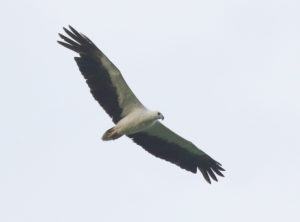
Starting our boat trip in the early morning will allow us to get out towards an area of submerged trees which stick out above the water and which are often favoured by resting raptors before thermals allow them to gain altitude. On one of these we hope to come across the smart Oriental Hobby. This is a scarce bird everywhere in Thailand but we have a good chance of finding it at this location. White-bellied Eagle is a fairly common bird on this lake so we can expect the very best of views of this magnificent bird both perched and in flight. If we are lucky we may see one catch a fish or if they are displaying then it is quite a sight to see them hold their wings in a steep “V”. At this time of year we are likely to see another fish-catching species of raptor in Western Osprey but there are two more species that we are going to be searching for; Lesser Fish Eagle and Grey-headed Fish Eagle. Both of these species are very rare in Thailand but they are both resident, nesting birds here and it is the best location in the country to see them. Lesser Fish Eagle is the commoner of the two here and we might be able to spot them in the early morning on a favourite perch while we hope to locate Grey-headed Fish Eagle in the vicinity of one of its regular nesting sites.

This is usually a good location for spotting a wide variety of raptors and we are likely to see several of the species that we have seen at the migration watch point, including Oriental Honey-buzzard. Rare species such as Jerdon’s Baza and Blyth’s Hawk Eagle are possible and seen here more frequently than at most sites and the list of possibilities is exciting. Of course, there are a number of species to find that are not raptors too. Chieow Larn Lake is a good site for encountering Hornbills. Gigantic Wreathed Hornbills often fly overhead, between the limestone cliffs while if we find a fruiting tree we can expect Oriental Pied Hornbill and hope for Great Hornbill or even the incredible Helmeted Hornbill. These birds are quite a spectacle flying between the misty peaks.
Looking overhead we have a chance to spot groups of Dusky Crag Martins that nest in small numbers here and if we scan the rocks we are likely to see the resident madoci subspecies of Blue Rockthrush. Touring around the shallow end of the lake we will hope to find Stork-billed and Blue-eared Kingfishers lurking around the water’s edge while dead trees give us a chance to spot woodpeckers and other birds resting in the open.
We will have lunch on one of the simple floating restaurants that are found on the lake before resuming our boat trip. Towards the end of the day we will travel back through the dramatic limestone karst scenery and then make a short drive towards our next location in preparation for some forest birding. This should be a memorable day for some great birds and awe-inspiring scenery.
Day 6, Kaeng Krung – Chumpon – 31st October 2025

We will take this opportunity to punctuate our progress back northwards with a morning of birding in the forest of Southern Thailand. The birds of this region are quite distinct from those of the forests a little further north so we should be able to add a lot of variety to our bird list for this tour. Small, arboreal birds that join flocks should include Green Iora, migrating Eastern Crowned Warblers, Chestnut-winged Babbler, Hairy-backed Bulbul and Lesser Green Leafbird. Malkoha species could include the colourful Chestnut-breasted Malkoha and Red-billed Malkoha and we can track down Black-and-yellow Broadbill by the sound of its call.
This location gives us another chance to see one of the rarer raptors in Jerdon’s Baza. More common species can include Crested Serpent Eagle and Crested Goshawk. If we find a fruiting or flowering tree then we should come across groups of small, colourful birds that include the smart Orange-bellied Flowerpecker, Crimson Sunbird, Yellow-eared Spiderhunter and Yellow-breasted Flowerpecker. Larger birds should join such birds at fruiting trees with handsome Red-throated Barbet and Grey-bellied Bulbul strong possibilities. Once again, the fact that this is migration time means that there should be a surprise or two, maybe Sakhalin Leaf Warbler or Tiger Shrike will show up and please us.
In the afternoon we will continue and return to Chumpon. We can find some time to do some birding in the area where we can try to find Pied Imperial Pigeon, Asian Glossy Starling and Vinous-breasted Starling.
Day 7, Khao Dinsor Raptor Watchpoint – Khao Sam Roi Yot – Petchaburi – 1st November 2025

Raptor movement fluctuates daily and different species pass through on different dates so coming back to Khao Dinsor gives us another opportunity to encounter some of the rarer migrant birds as well as enjoy and photograph the more expected species. For anyone with a camera this site is a great opportunity for flight shots of raptors as well as any other passage migrant species.
After lunch we will start traveling northwards up the peninsula back towards the town of Petchaburi, stopping at the lotus swamp of Khao Sam Roi Yot national park. Here a profusion of waterbirds will include Grey-headed Swamphen, Purple Heron and hopefully Eastern Marsh Harrier. We should find returning Oriental Reed Warbler, Black-browed Reed Warbler and Pallas’s Grasshopper Warbler and we can check an area for the globally rare Manchurian Reed Warbler which winters here in small numbers. The scenery here is quite impressive too with a massive limestone upthrust forming the backdrop to the lotus swamp.
We will continue our journey to Petchaburi where we will spend the night.
Day 8, Pak Thale/Laem Pak Bia – 2nd November 2025
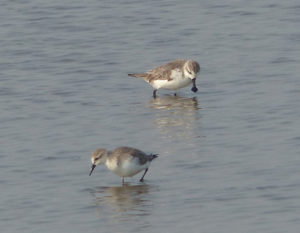
From raptors we will turn our attention to shorebirds. Pak Thale is the famous site on the Gulf of Thailand where Spoon-billed Sandpiper regularly winters along with huge numbers of other shorebirds. Although it is fairly early in the season our timing is such so that we can enjoy raptor migration as well as be in the right place for the first returning Spoon-billed Sandpipers. This critically endangered species usually arrives at the end of October and we expect to find it in a reliable spot. Here we are also sure to see a lot of other species of shorebirds including groups of smart Broad-billed Sandpipers, large numbers of Marsh Sandpipers, a flock of Eurasian Curlews that normally contain a few Far Eastern Curlews, Terek Sandpiper, Red-necked Stint, Long-toed Stint and groups of Great Knot.
At this time there should also be returning Nordmann’s Greenshank and Asian Dowitcher should be passing through as well. We have a whole day in this area to enjoy the flocks and variety of shorebirds on offer. Other species should include White-winged Tern, Painted Stork, Gull-billed Tern, Indochinese Bushlark, Indian Nightjar and Plain-backed Sparrow. However, just enjoying the spectacle that large numbers of shorebirds here create will be memorable in itself. A boat trip to a sand bar gives us a chance to spot Chinese Egret, more Malaysian Plovers plus the taxonomic quandary that is White-faced Plover.
Day 9, Kaeng Krachan National Park – 3rd November 2025
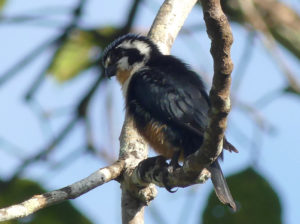
Today will be a real change from the previous day, visiting the forest at Kaeng Krachan National Park. Starting at sunrise we are here to add another raptor to our list; the charming little Black-thighed Falconet. These superb little falcons are loyal to a particular part of the forest so we have an excellent chance of seeing them well. It is a strange site to see these birds feasting on butterflies! In the same area we have a really good opportunity to see some amazing forest birds. These include noisy Sultan Tit, Great Hornbill and the stunning Black-and-red Broadbill. Early morning bird activity usually produces Thick-billed Green Pigeon, Asian Fairy Bluebird, Green-eared Barbet and Blue-eared Barbet perched out in the open. Noisy Greater Flameback and Common Flameback are usually very active in the morning and we might also find cute little Heart-spotted Woodpecker at the same location.
Spending the morning in lowland forest means that sightings of Crested Goshawk and Crested Serpent Eagle are likely while there will always be a supporting cast of Bulbuls, Drongos, Barbets, Leafbirds, Flycatchers and other arboreal birds to enjoy. Flashy tropical forest birds like Blue-bearded Bee-eater and Black-and-yellow Broadbill are guaranteed to amaze but we will not neglect little brown jobs such as Radde’s Warbler or Asian Brown Flycatcher.
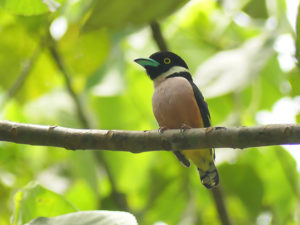
Our accommodation has pleasant gardens where we can have lunch and do some birding too. Birds such as Lesser Necklaced Laughingthrush, Puff-throated Babbler, Black-hooded Oriole, White-rumped Shama and Greater Necklaced Laughingthrush are frequently seen here and at night we might be able to find Brown Boobook and Collared Scops Owl.
Kaeng Krachan is a fantastic location and always produces a lot of good birds regardless of the time of year. During our day here we will decide on exactly which parts of the forest to go birding in based on up-to-date local knowledge. Perhaps we will visit a hide in hope of seeing a Partridge or Scimitar Babbler or maybe we will drive uphill to look for higher altitude species.
Day 10, Kaeng Krachan or Pak Thale – 4th November 2025
The last day of this birding tour in Thailand offers us a variety of choices. If we did not find Spoon-billed Sandpiper before we will make another effort this morning, or perhaps go in search of any other rare shorebirds. Perhaps we did not get a nice adult male Pied Harrier earlier in the trip and we could use time on this day to revisit rice fields where there would be a very good chance of finding one.
If these target species have already been found and enjoyed then we could visit an area of dry woodland in search of Black-headed Woodpecker, an area where Asian Barred Owlet and Spotted Owlet can also usually be found. Another alternative would be to look for Indian Thick-knee in savanna-like patches of grassland. There are a lot of possibilities for us on this final day and we will decide what to do at the time; we will be staying at a location which gives us a lot of flexibility in where to go birding.
In the late afternoon we will drive back to Bangkok where we check into our comfortable airport hotel and have a final dinner together.
Day 11, Departure – 5th November 2025
The hotel that we use on the last night has a free shuttle bus service to nearby Suvarnabhumi Airport with a schedule that runs twenty-four hours. Your transfer will be at a time agreed by you and the hotel according to their schedule.
The following is a list of key bird species that we have a high chance of finding based on the experience of previous visits. This is not an exhaustive list of target birds but they are some of the regional highlights that we will put effort into finding and birds that we think are highly memorable and/or regional specialities. Equally we cannot guarantee that all of these Thai birds will be seen but we do expect to locate a high proportion of them.
- Pink-necked Green Pigeon – Treron vernans
- Painted Stork – Mycteria leucocephala
- Black-headed Ibis – Threskiornis melanocephalus
- Yellow Bittern – Ixobrynchus sinensis
- Malaysian Plover – Charadrius peronii
- Great Knot – Calidris tenuirostris
- Broad-billed Sandpiper – Calidris falcinellus
- Long-toed Stint – Calidris subminuta
- Spoon-billed Sandpiper – Calidris pygmaea
- Asian Dowitcher – Limnodromus semipalmatus
- Terek Sandpiper – Xenus cinereus
- Nordmann’s Greenshank – Tringa guttifer
- Brown Boobook – Ninox scutulata
- Collared Scops Owl – Otus lettia
- Oriental Honey Buzzard – Pernis ptilorhynchus
- Black Baza – Aviceda leuphotes
- Crested Serpent Eagle – Spilornis cheela
- Blyth’s Hawk Eagle – Nisaeatus alboniger
- Greater Spotted Eagle – Clanga clanga
- Booted Eagle – Hieraeatus pennatus
- Eastern Marsh Harrier – Circus spilonotus
- Pied Harrier – Circus melanoleucos
- Crested Goshawk – Accipiter trivirgatus
- Shikra – Accipiter badius
- Chinese Sparrowhawk – Accipiter soloensis
- Japanese Sparrowhawk – Accipiter gularis
- White-bellied Sea Eagle – Haliaeetus leucogaster
- Lesser Fish Eagle – Icthypyga humilis
- Grey-headed Fish Eagle – Icthypyga ichthyaetus
- Brahminy Kite – Haliastur indus
- Grey-faced Buzzard – Butastur indicus
- Orange-breasted Trogon – Harpactes oreskios
- Great Hornbill – Buceros bicornis
- Oriental Pied Hornbill – Anthracoceros albirostris
- Wreathed Hornbill – Rhyticeros undulatus
- Blue-bearded Bee-eater – Nyctyornis athertoni
- Stork-billed Kingfisher – Pelargopsis capensis
- Black-thighed Falconet – Microhierax fringilarius
- Oriental Hobby – Falco severus
- Black-and-red Broadbill – Cymbirhynchus macrorhynchos
- Black-and-yellow Broadbill – Eurylaimus ochromalus
- Sultan Tit – Melanochlora sultanea
- Indochinese Bushlark – Mirafra erythrocephala
- Black-browed Reed Warbler – Acrocephalus bistrigiceps
- Pallas’s Grasshopper Warbler – Locustella certhiola
- Lesser Necklaced Laughingthrush – Garrulax monileger
- Greater Necklaced Laughingthrush – Garrulax pectoralis
- Vinous-breasted Starling – Acridotheres leucocephalus
The map below shows the main birding sites that we will visit on this Thailand raptor tour.
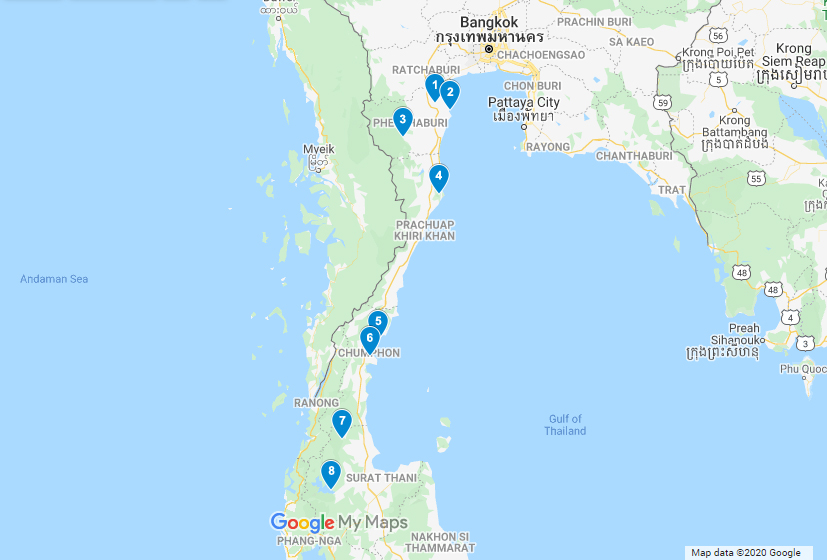
1. Petchaburi Rice Fields
5. Khao Dinsor
2. Pak Thale & Laem Pak Bia
6. Chumphon
3. Kaeng Krachan National Park
7. Kaeng Krung National Park
4. Khao Sam Roi Yot National Park
8. Chieow Larn Lake
The following is a selection of birds photographed in Thailand at sites that we will visit on this tour.
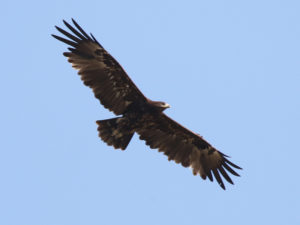
Greater Spotted Eagle 
Eastern Crowned Warbler 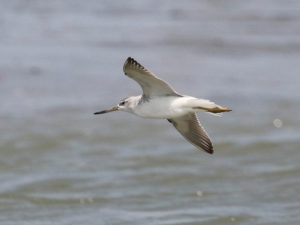
Nordmann’s Greenshank 
Pink-necked Green Pigeon 
Western Osprey 
Lesser Sand Plover 
Baya Weaver 
Eastern Marsh Harrier 
Marsh Sandpiper 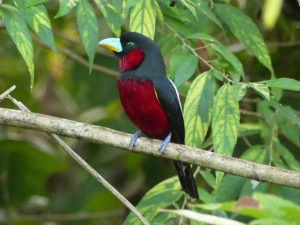
Black-and-red Broadbill 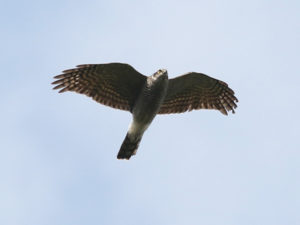
Eurasian Sparrowhawk 
Vinous-breasted Starling
All above photographs copyright Nick Upton/Calidris Birding Tours.
Tour Details
Tour Cost: £3200 per person
Single supplement: £500
Included in the tour cost: All transport including airport transfers, all meals, accommodation (based on two people sharing a room) including a hotel on the day of arrival and on the final night of the tour, bottled drinking water, national park entry fees, boat trip, services of English-speaking birding guide and Calidris Birding Tours guide.
Not included in the tour cost: International flights, travel insurance, visa (most nationalities get 30-day visa-free entry), alcoholic and soft drinks, tips, excess baggage fees, laundry and any other items of a personal nature.
Accommodation: All accommodation on this tour is of a good standard. All rooms have en-suite toilet and showers as well as air-conditioning. Hotels and guest houses are all the best balance of proximity to the birding sites with quality and convenience. Wifi is available at all locations.
Physical effort: Most of the birding in Thailand does not require much physical effort. Birding along roads and tracks that run through forests and wetlands is the normal plan on much of this trip. However, accessing the raptor watch point requires hiking for around 30 minutes along a forest trail. At points this trail has an uneven surface but there will be plenty of time for negotiating it. For anyone who did not bring a trekking pole we can easily cut a walking stick from nearby bamboo. Participants need to be mobile enough to be able to get on and off of a small boat from a jetty.
Weather: At most times expect the weather to be quite hot and humid throughout. At this time of year there are likely to be some sharp showers too but extended periods of rain are not likely.
Food: Thai food is famous as one of the world’s most popular cuisines. Although Thai food is famously spicy, most dishes can be cooked to suit all tastes to beenjoyed by everyone. Thai cuisine uses a variety of stir-fried dishes eaten with steamed rice. Most dishes contain meat or fish but catering to vegetarians is not a problem at all. Vegan food can is also possible although it may take a little more time in preparation. We can also cater for people with food allergies but please advise us in advance of any eating requirements you have so that we can check that we can indeed provide for you.
Tour Leaders

Nick Upton
Nick Upton has been birding since the age of seven and leading birding tours full-time since 2007. After travelling extensively in Asia he settled in Thailand in 1997, teaching English and science while establishing thaibirding.com. With a BSc (Hons) Wildlife & Countryside Conservation he is well placed to understand the ecology of birds as well as the conservation issues that affect them.
Nick is co-founder/director of Calidris Birding Tours.

Wich’yanan (Jay) Limparungpatthanakij
Jay has been a nature enthusiast for as long as he can remember making it a pleasure to share this passion with others when leading birding tours. With his MSc thesis focusing on “avian mixed-species flocks in lowland deciduous forest” his knowledge of Thai birds can be tapped into throughout this tour. Jay’s experience working on raptor counts will be invaluable.
Wich’yanan is co-author of Birds of Thailand.
While we make every effort to adhere to the advertised itinerary for this Thailand raptor birding tour, we reserve the right to make changes in the case of unforeseen circumstances that are beyond our control. These can include problems with accessibility, national park closures, unseasonal weather events or any other reason that may demand a change of itinerary.
Recommended Field Guide
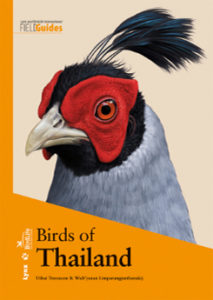 Birds of Thailand
Birds of Thailand
In 2018 Lynx Edicions solved the problem of which field guide to recommend for Thailand birding tours with this publication. This guide contains all of the species we are likely to see on this bird watching tour and deals with the question of varying taxonomies extremely well. We recommend that all participants on this tour obtain a copy of this book. The checklist Calidris Birding Tours will issue for this trip will use IOC taxonomy with reference to the taxonomy used within this field guide.
When booking this Thailand Birding Tour customers will receive a 10% discount code for use when ordering the book directly from Lynx Edicions.
Read our full review of the book here – Birds of Thailand.
Related Birding Links
- Chumpon, Hotel Grounds & Golf Course Birds – posted by Nick Upton 18/06/19
- Garden Birding at Baan Maka – posted by Nick Upton 29/10/18
- World Conservation Wader Watch – posted by Nick Upton 10/11/17
- Shorebird Heaven – posted by Nick Upton 12/11/16
- Chumpon Raptor Watch & Petchaburi Wetlands, 21-25th October 2011 – posted by Nick Upton 27/10/11
- Khao Dinsor Raptor Migration Watchpoint – by Chukiat Nualsri & Robert DeCandido 2010
Terms and conditions: Please read full Calidris Birding Tours terms and conditions which apply to the Thailand Raptor Birding Tour.



